Half-Life 2 has my favourite moment in any game. It’s this:
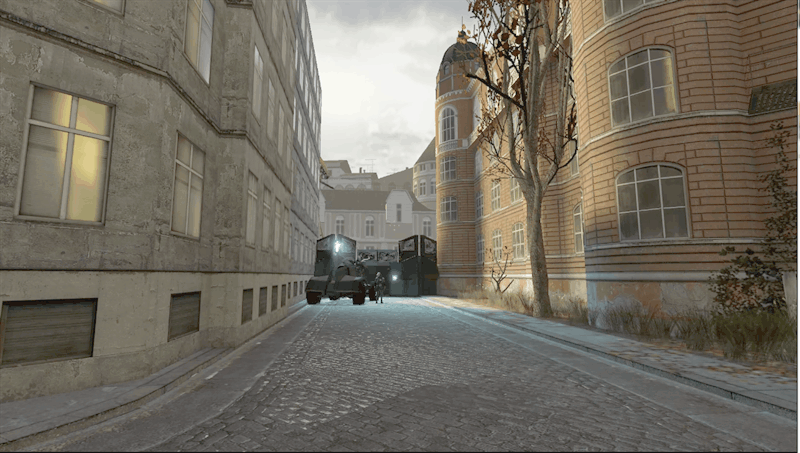
I never played the original Half-Life, so I didn’t understand a lot of what was going on in Half-Life 2’s opening minutes. Half-Life 2 makes it clear from the get-go that something is wrong: your sudden appearance on the train after G-Man’s eerie monologue, Dr. Breen’s nervous introduction to City 17, the totalitarian anxiety that seeps from the civilians in the train station. The scanners and Barney’s clandestine operations clued me in that we weren’t in any usual rendition of Earth, but it wasn’t until I turned that corner and saw that Strider lumber by that I knew I was distinctly somewhere else. This kind of moment is one of my favourite things in games — that combination delight/horror of asking “What the hell is that?”
This was also my first encounter with this feeling. Half-Life 2 is the first shooter I ever played all by myself. I picked it up after watching a partner play Portal, intrigued by the hints to the world of Half-Life Valve peppered the Aperture labs with. My partner had had no interest in Half-Life 2 or in any game involving shooting, now one of my favourite genres. He had also recently dumped me, so playing it, even though I’d never played an FPS before, felt like some kind of escapist middle finger, or at least something to do besides cry.
In the intervening years I’ve approached 100 hours with the game, played countless other shooters, and even wrote my library school Master’s thesis about Half-Life 2 and ‘affective information behaviour.’ But it’s still hard for me to look at Half-Life 2 as anything other than where I learned video games, where I first encountered all of the things that have become a core part of how I find pleasure in the world: navigating a first-person perspective with a mouse, switching weapons with the number keys or the mouse wheel, jumping with the space bar. These automatic actions belong to Half-Life 2 for me, or it’s the game that gave them to me; I will always see Half-Life 2 as a place more than a game.
There was this part, early on:
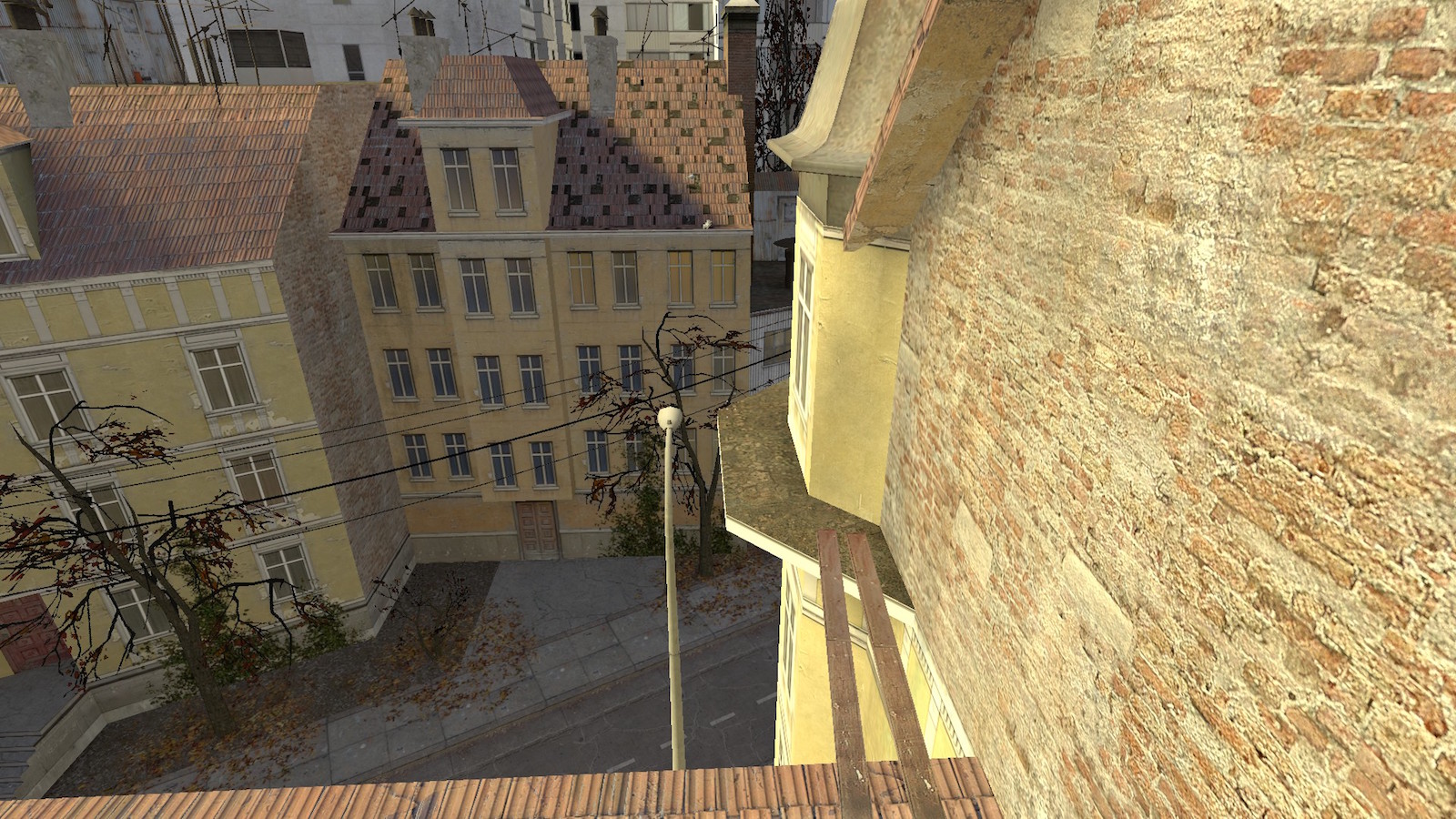
I fell off this roof so many times. I didn’t understand first-person platforming; I didn’t know where to look, where my body was in space. I screamed as Civil Protection shot at me (I still do this), and I plummeted to the pavement, over and over and over. In subsequent replays I’ve blazed through it, and I’ve since crossed bridges much more precarious than this so many times I can’t even remember them. But whenever I come back to Half-Life 2 I’m always dogged by the ghost of that first time. The opening chase still makes my heart pound, still draws my attention to the things I have to do with my hands to enter the world of a video game, so simple now but so foreign at the time.
The opening chase that initially stymied me sets the tone for the game’s brilliant first half, a pace that feels uniquely Half-Life 2. Coming back to it now, the game’s early hours remain eminently playable. Half-Life 2 excels at imparting information. Enemies, allies, and supplies are consistently marked through visual design or audio clues. You get a crowbar and then are immediately introduced to the kinds of boards it can break, one example of the game’s consistent visual language. Later weapons are tutorialized in similar ways: a new concept is introduced in its ideal circumstance, you have a chance to practice it, then you get to experiment with it and scaffold it onto the skills you already have. It creates a player who is in control, who can effortlessly navigate the game world to do what they want to do, who feels confident and empowered and all the words games trip over themselves to promise us now.
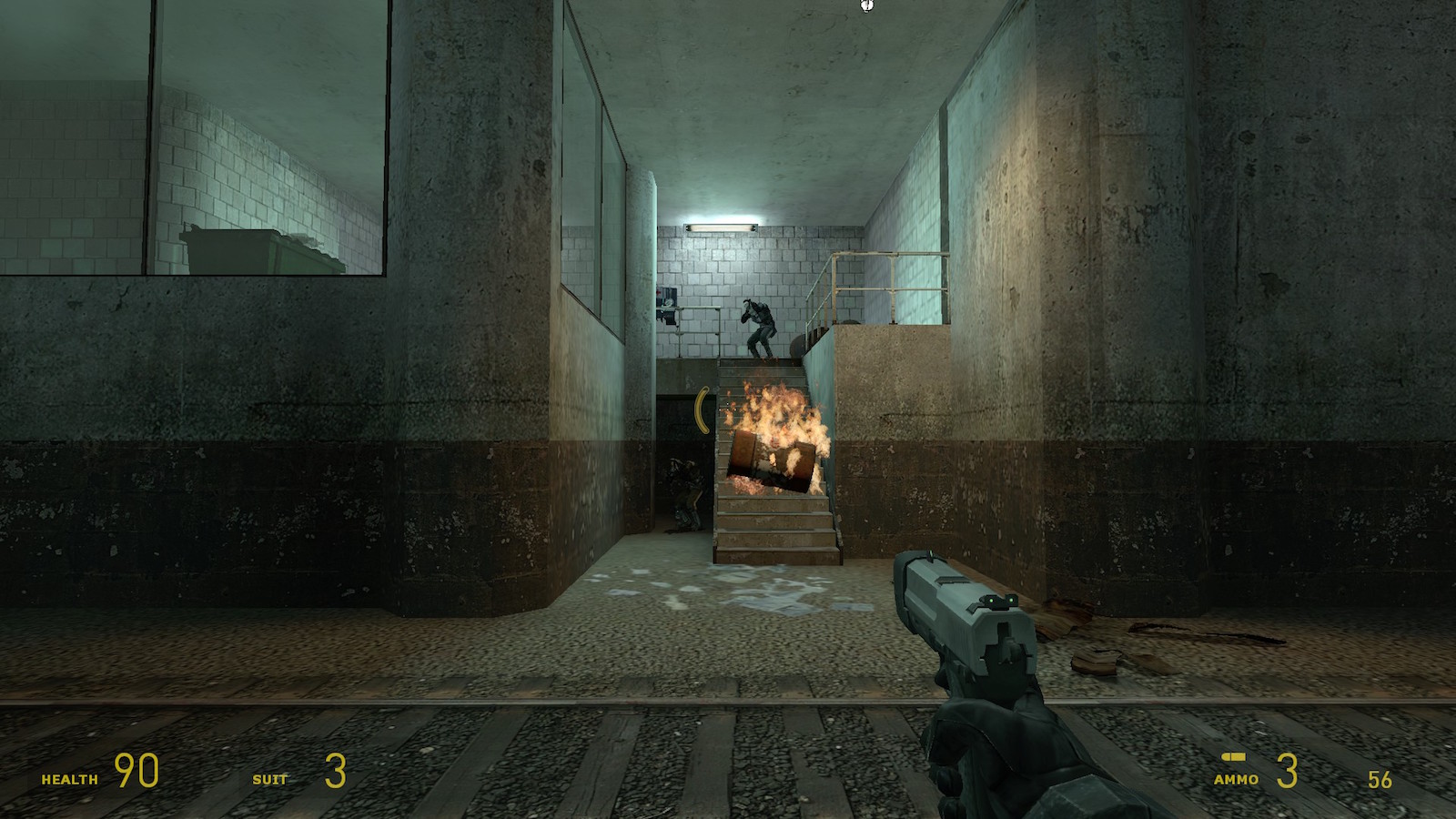
It also creates a world that’s easily legible, even when it’s foreign. You know exactly which kind of headcrab is hiding behind those boxes based on its unique chitter, or that a boss battle is coming from the distinctive infinite ammo crate squeezed in the shelter of a tellingly open area. The way you’re meant to go is signposted so naturally that it’s all but impossible to get lost or even realise you’re navigating at all, from the first moment stepping off the train all through the sewers and the canals. These early chapters remain tonally consistent in their pace, ceaseless pursuit punctuated by sudden quiet moments. You dodge Civil Protection through the sewers, pausing to solve small puzzles, a pattern that repeats during the scout car journey along the coast. During the airboat chase, along with ramps that have to be dropped and locks that have to be lifted, there’s a small camp off in a side area with dead bodies, mattresses, and an abandoned bicycle; in the silence, you can hear windchimes banging. These sections pound and dip like a heartbeat, pushing you forward without being overly frantic, giving you small moments of respite.
Many of these pauses involve physics puzzles, Half-Life 2‘s claim to fame. These don’t feel as revelatory as they perhaps once did, especially now that I’ve played so many other games. Coming back for this review, I was strangely relieved to find the vehicles still difficult to navigate, little bumps stopping my airboat as if I’d smacked head first into a wall. The X-number-of-counterweights-to-move-Y-object is fumbly and repetitive at times. The guns feel similarly underwhelming — the machine gun may as well be a peashooter, the pulse rifle’s main fire oddly underpowered for its sound effects.
Despite how many times I’ve played Half-Life 2, my latest playthrough for this review was only the second time I’ve been to Ravenholm. Back when I didn’t know how to play shooters this level terrified me, and to be honest it still does. The sudden dramatic shift makes everything more frightening — that steady forward momentum shifts to dead-ends and backtracking, punctuated by jump scares and zombie hordes. We’ve seen headcrab zombies once or twice in previous levels, but after Ravenholm they spill out into the rest of the game, creeping along the hills by the bridge or fighting Combine troops back in City 17. The game suggests the Combine created them, or, with their rockets full of headcrabs, at least deploys them intentionally, but they steadily overtake both you and your enemies.
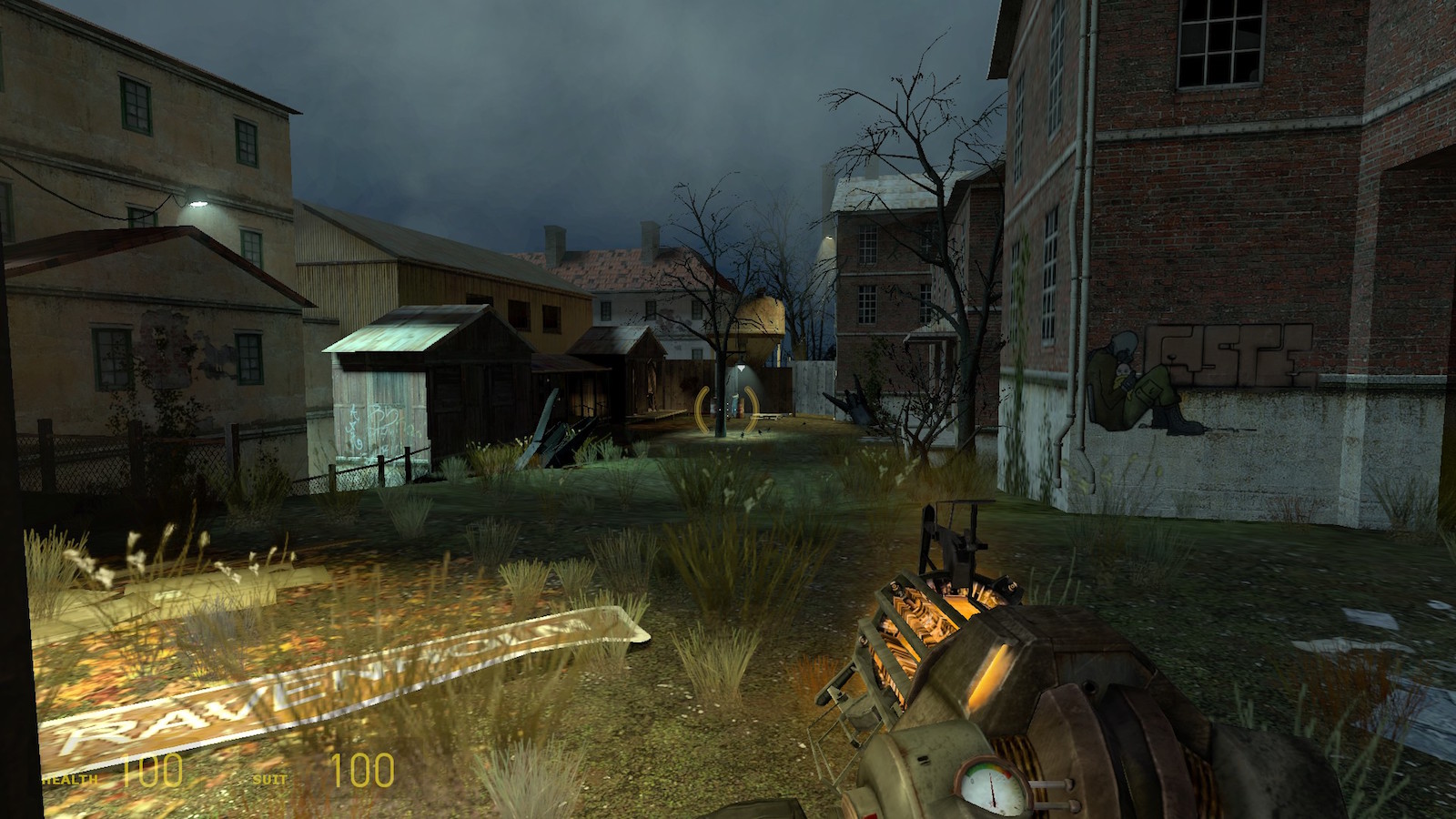
This subtle touch — zombies fighting Combine — illustrates the broader movements of Half-Life 2‘s world, the machinations you move alongside but aren’t entirely responsible for. Gordon Freeman isn’t single-handedly bringing down the Combine, despite what NPCs seem to suggest when they marvel at your presence.
In the years Gordon’s been in stasis since the events of the first Half-Life, the Combine have taken over the Earth. This initial surge was effortless, according to the newspaper clippings you can find around, but things don’t look so good now. It’s never entirely clear where you are in the world, or how this particular country fits into the larger hierarchy of the Combine’s rule over humanity.
If Doctor Breen is the entire Earth’s Administrator, however little power that title actually affords him, the Combine have centered humanity’s power in an unideal location. You aren’t in an urban center; you’re in some Eastern European backwater country whose scope, given your journey, is difficult to fully map. City 17 is falling apart, and there aren’t any towns after it; the City gives way to nothing but countryside. Combine ambush Gordon from outposts in shattered houses and abandoned petrol stations set along broken highways. Nova Prospekt, the base of operations for the Combine’s transhumanist experiments, is in inexcusable disrepair for such a central stronghold. Though the game throws countless soldiers at you when you arrive in the prison, you find them hiding behind old bed frames and flimsy turrets, jumping down from collapsed floors and falling to the antlion infestation that was clearly well in progress before you and your bug bait brought more of the beasts in. When you return to City 17 to foment the uprising, everything has fallen apart. This collapse seems structural as much as to do with the citizens, those mindless ducklings who block doorways and seem to do little before you arrive. The Combine itself, whatever it is, may be absolute, but its ground troops are on the losing end of some kind of long, badly-planned battle.
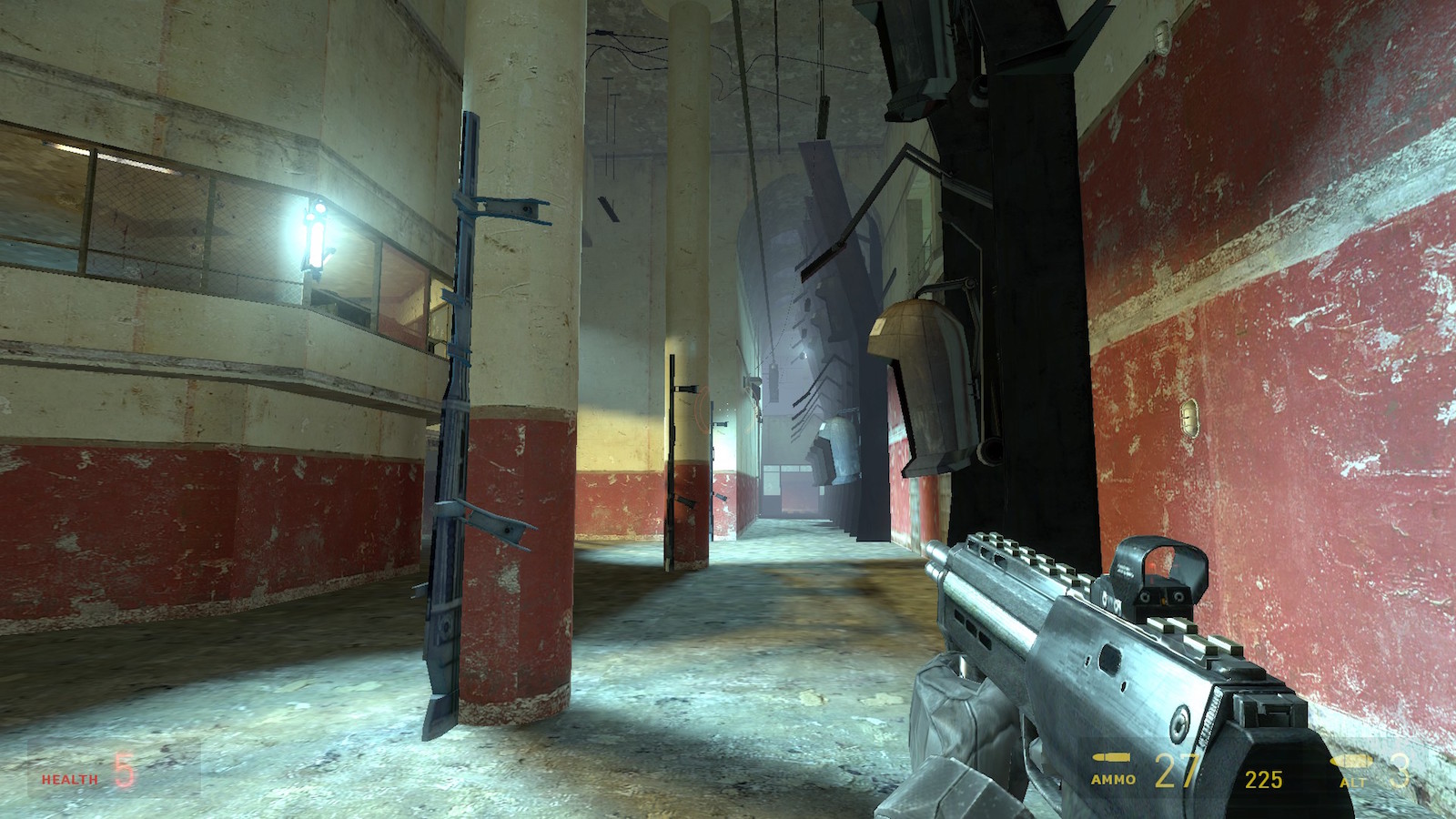
I’ve never been clear on what exactly the Combine is. The design of their architecture is unique and strikingly alien, from the way the Citadel rises up violently above City 17’s skyline to the black, angular outposts along the coast on your way to Nova Prospekt. It’s hard to say what Combine buildings are made of: the material looks shiny and impenetrable where it’s frankly jammed into the existing space, but at the same time the edges are caked in weeping water stains. The Combine’s distinctive blue barriers are powered by unwieldy plugs that run on Earth electricity; they flop ridiculously on thick cords like a prop in an underfunded school play. Combine soldiers huddle around pounding thumpers or stand guard in uncomfortable, exposed towers, as out of place in their own architecture as humans are.
None of this was meant for living things to inhabit; bodies are a problem for the Combine in some unspecified, disturbing way. You can see it in the pod that carries Eli Vance, or the knife-like shape of the transport trains, or the vertiginous interior of the Citadel threaded with narrow glass walkways and uselessly jumbled cables in unserviceable shafts. The actual Combine — something other than the soldiers or the larval boss Doctor Breen meets with or Civil Protection or the snipers — is some kind of force completely removed from the bodies that carry out its will. The Combine is an idea, forced on its agents as callously and violently as it’s forcing itself onto Earth.
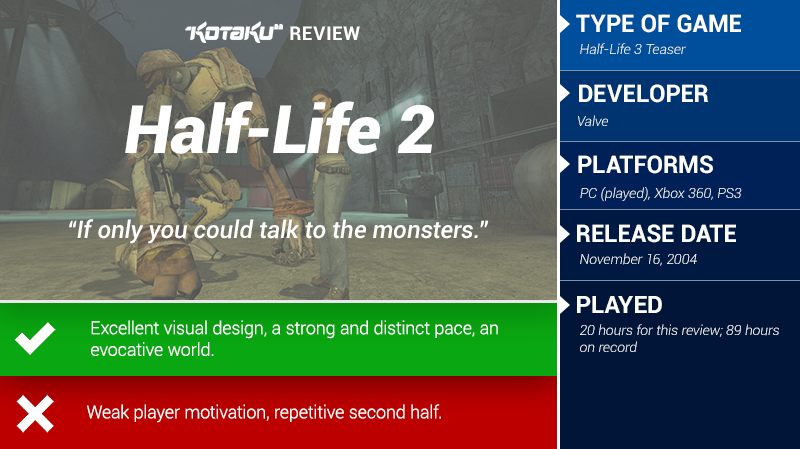
Half-Life 2 makes it hard to tell if something is alive or not. Combine objects behave like people; the scanners, manhacks, and rollermines move of their own volition, with sound effects and behaviours that reflect real personalities. The gunships move like swordfish, or whales; the dropships alight like indecisive insects, some combination of living and mechanical that is all part of the Combine’s increasingly ill-fated plan.
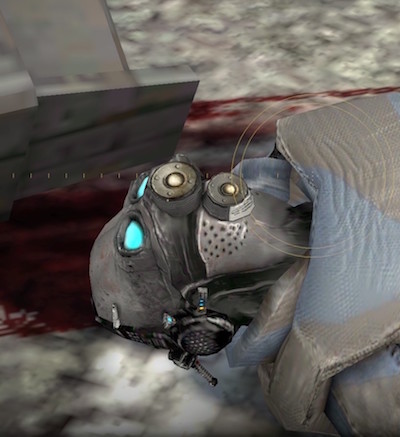
Even the Combine troops aren’t entirely people. Their heads don’t make sense, the shape of their helmets and their multiple breathing holes and misplaced bug eyes. The later troops have one red visor to see from, unnervingly centered. It’s obvious some kind of experimentation is going on, but, judging from Breen’s warnings as Gordon Freeman wreaks his havoc, it’s still in the early stages; the Combine could still pull the plug if humanity can’t get itself up to snuff. Civil Protection officers occasionally display a personality (the “shit” before they’re blown up by a grenade remains a lovely, subtle touch) but if the Combine is attempting to merge with humanity, it isn’t doing a very good job. Even the Combine logo is confused, a cross between a building and a human, like the Combine apparatus isn’t quite sure what humans are for.
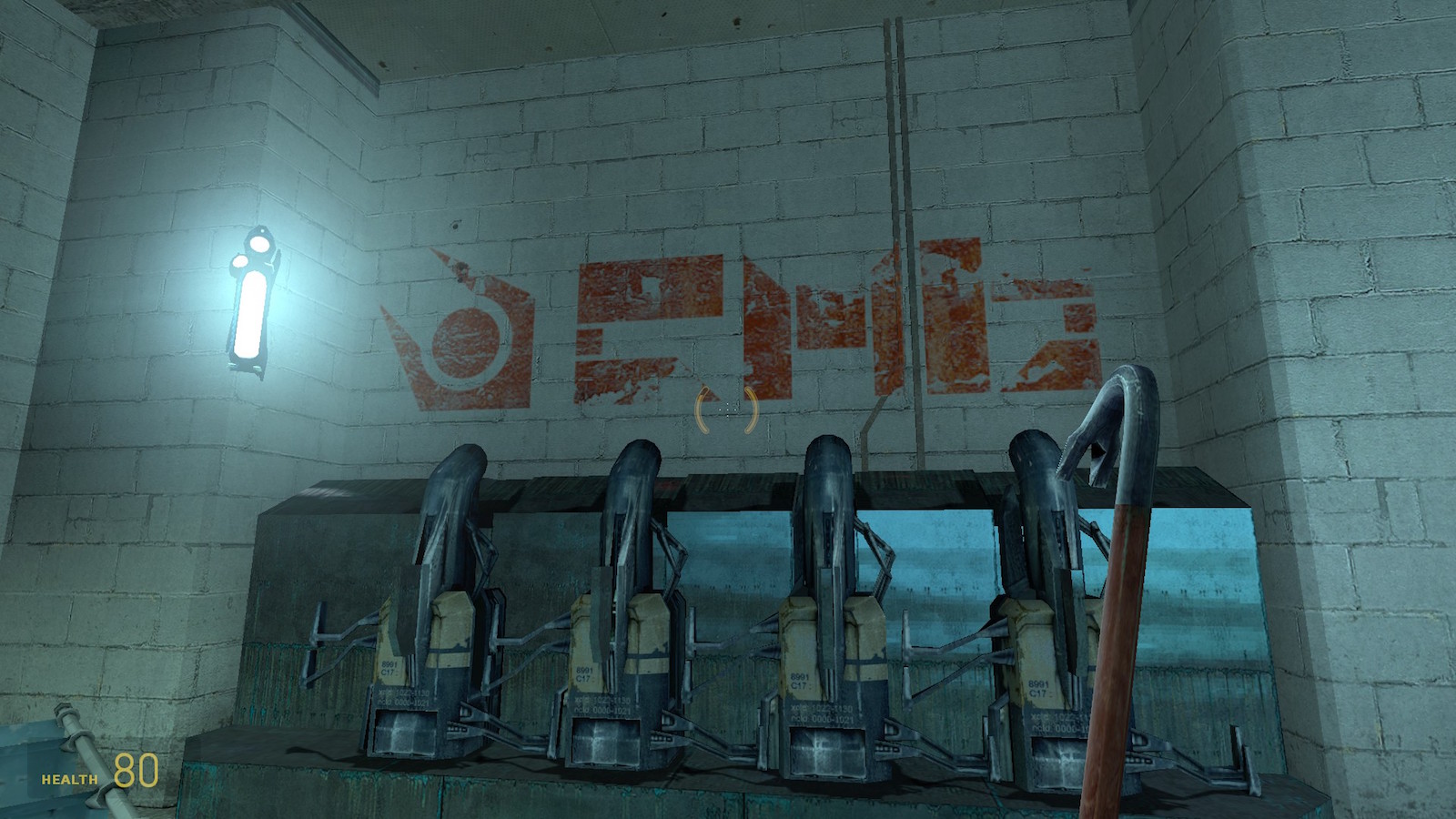
The thing is, Half-Life 2, as a game, isn’t quite sure what humans are for either. What I love it for — the clarity of how its information is presented; the long, natural tutorializing that Valve excels at in all of their games; the uncluttered flow of its momentum — are things that have nothing to do with character, motivation, or emotion. While many people hold up Alyx Vance as some pinnacle of game characterization, I’ve never found her compelling. She is so enamoured of Gordon so quickly, but you hardly know her, and I’ve always found her admiration uncomfortable and undeserved.
The people around Gordon have complex relationships with each other, ones that unfold through well-scripted moments and wonderful voice acting, but you’re always outside of them, a needlessly silent observer. Gordon is shuttled from place to place for reasons that are never his own, flipping switches and shooting guns and being lauded at every turn, all while never once making his own choice as to where to go. It’s suggested that the G-Man is part of this, orchestrating things from behind the scenes; having control snatched away from you in the game’s final moments hammers this suggestion home, but Half-Life 2 doesn’t try to say too much about agency or power. Held up to more recent games, ones that go out of their way to give you motivation even when it’s shoehorned or flimsy, Half-Life 2 doesn’t seem to care at all if you care about why you’re doing the things you do. It funnels you ahead unceasingly, lauding you awkwardly for doing what it tells you to.
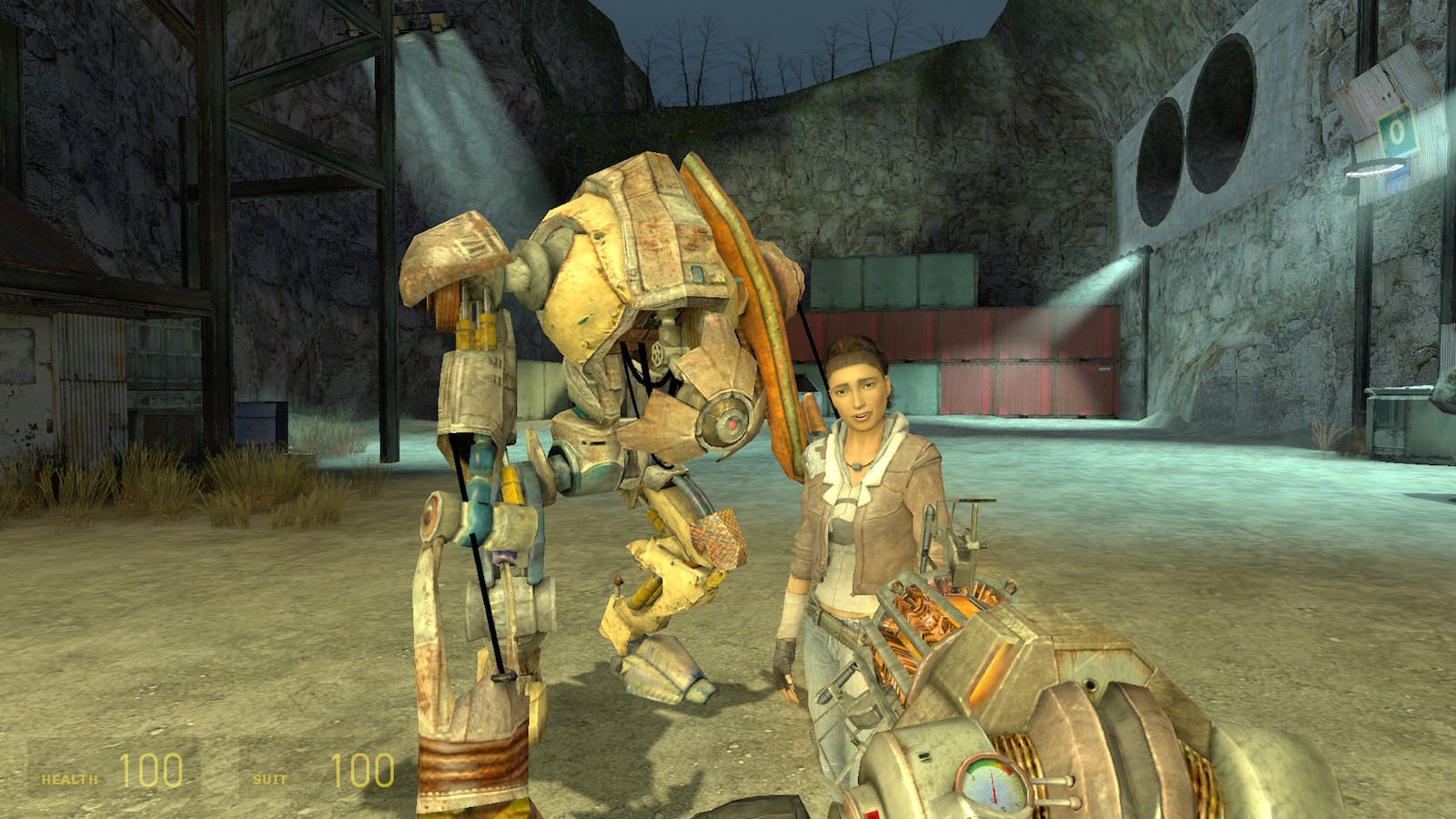
It’s how everyone says your name — Gordon Freeman! — that feels ridiculous, the laziest kind of player praise that it doesn’t need given the tools it provides you with for feeling competent. That disconnect was present for me the first time I played, because I was so mystified by the game; it remains present for me now, how the entire world has just been waiting for you and only you to arrive. I’ve never read the game as a power fantasy like other shooters; it seems too understated for that somehow, too polite, but it seems to fall to that end of the spectrum nevertheless, like power fantasies are obligatory, like that’s what it thinks I want. Half-Life 2 gives so much care to being played that it fails to consider, or at least isn’t concerned with, who is actually playing it.
After Ravenholm, the game goes full-out on this angle. The back end of Half-Life 2 is all bombast, all shooting and shooting and shooting. After Nova Prospekt it’s never quiet, and you shoot waves and waves of enemies during increasingly repetitive tasks. Disable three generators; go to the roof just to go back down just to go back up just to go back down; take down Striders in the courtyard and then take down some more in the rest of the City. Even those Striders, those magnificent monsters that took my breath away, become tedious as the end of the game plays out.
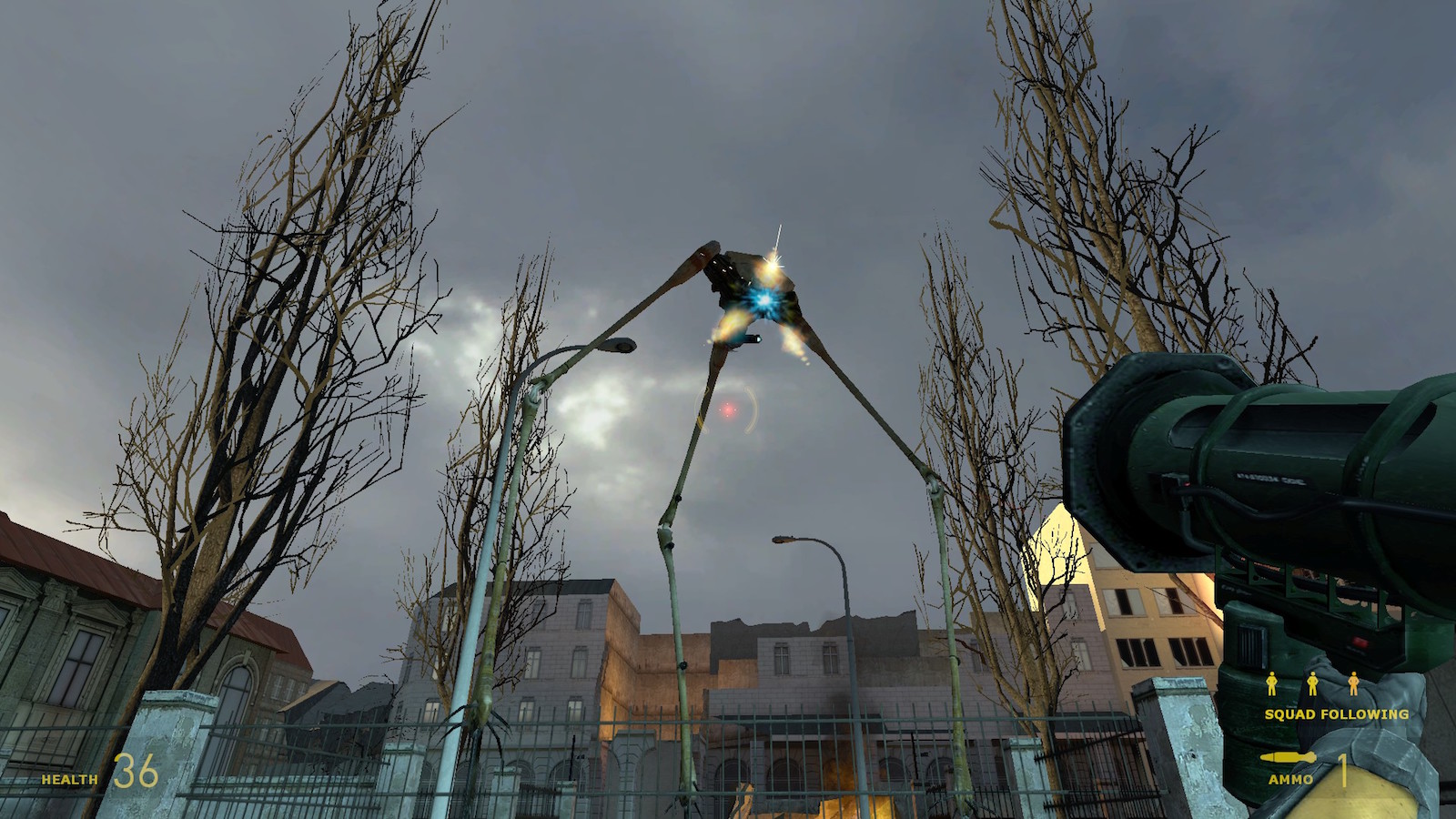
Most of the Citadel is an on-rails power fantasy. The blue Gravity Gun is awesome, but it removes any possibility of stakes or challenge. You blast through the Citadel like any old action hero, given no opportunity to examine it like one would assume a scientist like Gordon Freeman would want to. The final battle has hard-to-read platforming and obvious solutions; it’s almost a complete throwaway after the long journey to get there. You’re held immobile as NPCs have emotions in front of you, your silent observation making it difficult to engage or care. There’s no heart to the game’s end, or indeed the entire game. It’s one of my favourites, but I’m love with my experience with it, more than I’m in love with it on its own.
“You destroyed so much,” Doctor Breen tells you in the end. “What have you created?” The modern FPS genre owes itself to Half-Life 2, for better or for worse. It’s easy to hold it up against its own children, and this last time through I even found myself thinking longingly of Wolfenstein: The New Order, of Dishonored, of Spec Ops: The Line. I know games now, the way I didn’t then. The bridge section, which felt so epic when I first played, now seems flimsy and padded-out, its platforming finicky, the enemies who appear predictable. But I’m only aware of the bridge’s shortcomings because Half-Life 2 gave me bridges. It’s got some pacing issues, sure, but it’s still a pretty good bridge.
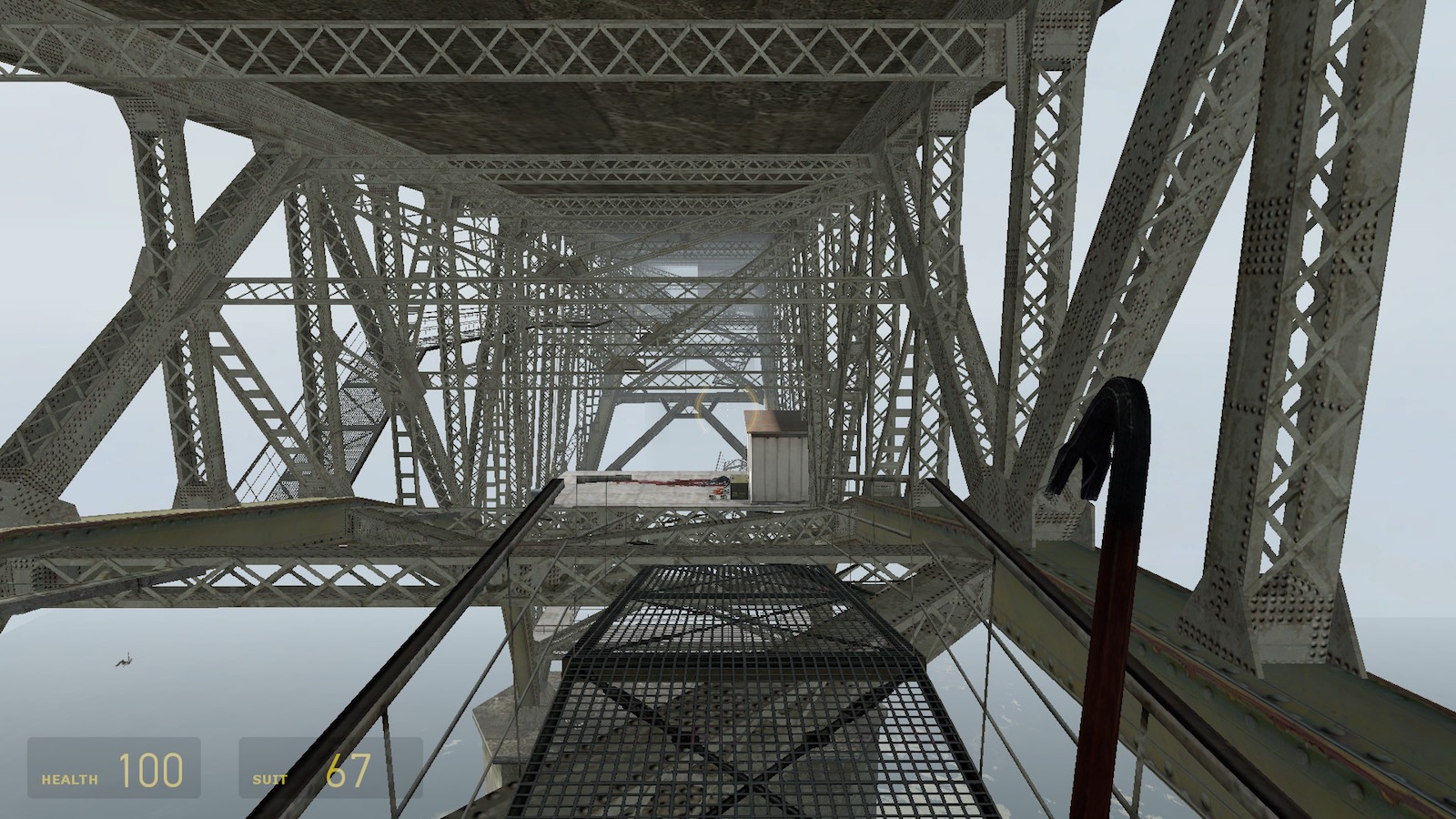
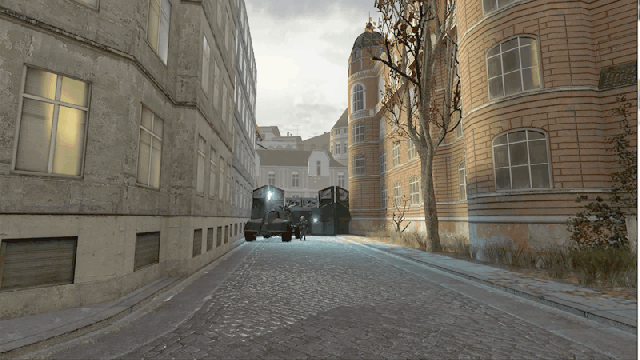
Comments
17 responses to “Half-Life 2: The Kotaku Review”
One cannot simply write an article on Half-Life 2 without the Dog vs Strider image.
As great as it was, Half-Life 3 could never be anything but a stock-standard first person shooter. Its got more hype than Duke Nukem which can only lead to disappoint.
Dog V Strider was episode 2, not technically part of Half-Life 2.
I was a bit late to the party on this one, having bought The Orange Box purely to play Portal and then checking out the other main game on the disc. The first hour or two absolutely captivated me. What a bizarre, scary world to be living in! I loved being “on the run” and trying to figure out how the heck the world reached this point!
… Then I picked up a gun.
I couldn’t help but feel, like I did with Bioshock Infinite, that the constant pew-pew actually removed me from the captivating, engrossing story. Suddenly what felt like a living, breathing world, turned into corridors and streets where I was constantly walking forward and shooting everything.
I’ve been meaning to play the expansions someday. Maybe I should go and do that.
HL2 is a bit like Blade Runner for me. The opening is so strong I forget how much I dislike the experience as a whole.
In particular I’m not a fan of the silent protagonist. If they’re not going to talk then you need some other way of showing character. Gordon Freeman is just a mute non-entity in his own game. The feeling of being trapped inside him pulls me out of the world constantly.
I never enjoyed HL2 and I really, really tried.
I loved Half Life, it changed my expectations of what a game could be. The story, the AI of the soldiers, the encounters with scientists, the weird G-Man appearing in the background. The sudden janks. The creepy as eff creatures and feeling that everything could cave in on you at any moment. Crawling through the vent and then seeing shafts of light appear through bullet holes appearing in the vent just in front of you as you scrambled backwards in panic…
HL2 however felt boring and tedious. I was so disappointed.
Instead of the tense pressure and great set pieces of the original game, this felt like, “Hi, I’m your companion, but I have to go now, so race through a bunch of meaningless battles as quickly as possible till we meet up again”. Then jumping in a boat or whatever and tearing through random feeling battles with faceless enemies. Then it repeating.
I was really hoping that 3 would come out and be a more tense, intriguing game, but it never came.
I don’t think it will live up to the hype. I might play it when it comes down in price.
Great review. It sums up a lot of the same feelings I had playing Half Life 2 the first time, having never played the first.
That bridge section though. I remember a while ago I was replaying and I just stopped, but couldn’t remember why. I loaded up the save recently, and it was in the middle of the bridge. No idea which direction I was supposed to be heading or what I was trying to do. I put it away again pretty quickly.
The bridge section is my favourite part 🙁
I really struggled with it. I remember being pretty bad at it when I first played – I died a lot. I think what probably didn’t help was that I was playing on XBox with a controller. But I remember getting turned around and not realising I was facing the wrong way and having to do it all again. But I think that says more about my own abilities than it does about the game.
To be fair it is pretty strange game design by today’s standards, but I love the atmosphere of the thing, sound design and clever use of fog to shorten draw distances really came together to make for a great atmosphere, part of what I thought was missing from the sequel (the bridge sequence reminds me a bit of the cliffside sequence in the first game).
The sequel was good but I always preferred the original. It was just so amazing for the time.
Not only for its time, I played it almost immediately before HL2 (long after HL2 was released as well, by that stage HL2 was looking pretty dated as well) and I still think it’s the better game. It had a sense of scale and imagination that was largely lost for me in HL2.
HL2: E2 is my favourite of the bunch though, combining the gritty world of HL2 with the cohesive journey and atmosphere of 1 all while adding the most enjoyable enemy I’ve come across in any single player game in the hunters.
A game so good I played through it on minimum settings at 25fps (in the quiet bits) and still enjoyed it!
I actually went back and played it a third time probably about three years ago (I played through it a second time when Orange Box launched) and I couldn’t believe how old it looked in the Xbox 360.
I agree with everyone who thinks it would be hard to live up to the hype if they make HL3. The FPS genre that the series hails from has changed so much that it would be really hard to make a game that felt like Half Life without making a game that felt stale.
Three years ago I thought they were waiting for the new-gen consoles to launch so they could make the game they want for a broader audience, I was expecting that they had plans involving the portal gun that would have required more grunt than the 360/PS3 were capable of….. Now I’m resigned to that fact that it’s just not happening.
It’s a massive waste of a franchise. I can’t believe that Valve can’t find even a 3rd party that they trust enough to make it, especially since they’ve got enough cash these days to take a risk or two and cancel it if it was an embarrassing disaster. Surely there’s no shortage of talented developers who’d KILL to get the rights to make a HL game.
I love HL2, i keep it installed on my PC whenever a replay calls.
I love the citadel levels with the super gravity gun, nothing better than playing combine bowling.
I still rank HL2 as the best FPS games of all time, and one of my favourite games of any genre. I think I’ve played it through at least a dozen times, and I’ve been playing bits and pieces of it fairly regularly since it was released.
Spoilers ahead… but the game has been out for 18 years, and if you haven’t played it yet oh my god what have you been doing with your life?
In terms of the reverence that characters place on Gordon Freeman, I can see how it would be a bit odd if HL2 was your entry-point to the series, but it makes sense following the events of HL1. Gordon Freeman single-handedly stopped the invasion from Xen, and freed the Vortigaunts from Nihilanth’s enslavement. Given the big part that the Vortigaunts play in the resistance (and that it was probably them that hired Gordon from the G-man), it makes sense that the resistance would see Freeman as some sort of superhero.This makes me sad. HL2 was one of the games that gave me really bad sim sickness. I tried and tried but just couldn’t play more than 20 mins of it without wanting to hurl. I remember it looking so amazing and wanting to play it more than anything but in the end giving up 🙁
I re-played this about a year ago. FakeFactory released their Cinematic Mod 2013. I’d last played CM10 so I thought it’d be interesting to see their progress. It’s pretty good.
http://cinematicmod.com/index.php